Salmon fishery statistics - 2012 season
Salmon catch statistics for Scotland for the 2012 season.
Catch And Effort Reported By Scottish Salmon Fisheries In 2012
The rod and line fishery
A total of 22,682 wild salmon and grilse were reported caught and retained in the rod and line fishery. A further 63,331 wild salmon and grilse were reported caught and released. The combined retained and released rod catch is 95% of the previous 5-year average. We have no time series of fishing effort information associated with the rod and line fishery.
Annual rod catch has increased over the period since 1952 and is currently at the high end of the observed range ( Figure 1). This increase in rod catch, together with the decline in the net fisheries ( Figures 4 and 5), has resulted in the total rod catch comprising 84% of the total Scottish catch in 2012 compared to 11% in 1952.
Trends in total rod catch vary among individual stock components ( Figure 2). Spring salmon catch (for the purposes of this report defined as multi sea-winter fish taken before 1 May) has generally declined over the period. The catch has stabilised in recent years and remains at a historically low level. Grilse catch, on the other hand, has generally increased over this same period while the summer salmon catch (multi sea-winter fish taken on or after 1 May) shows little overall trend.
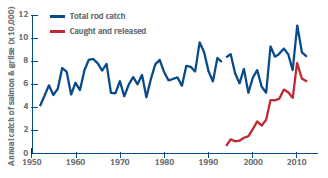
Figure 2 Trends In Stock Components, Rod And Line Fishery
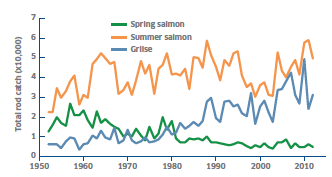
Catch and release
The proportion of the rod catch accounted for by catch and release has generally increased since 1994, when such information was first recorded. In 2012, 74% of the annual rod catch was released compared to less than 8% in 1994. Similarly, less than 1% of rod caught spring salmon were released in 1994 while 91% were released in 2012 ( Figure 3).
Figure 3 Catch and release, rod and line fishery

Comparison of catches among geographic regions
Analysis at finer geographical scales reveals differences among regions in the relative strength of 2012 catches compared to available historical data. Annual reported rod catch (retained and released) for each region was ranked over the time series from 1952 to the present (1=lowest, 61=highest). The rank values for the 2012 catch for each region are shown in Figure 4. Orkney and Shetland have been omitted from this regional analysis as they are not considered to have been fully covered by the survey over much of the time series.
Figure 4 Relative Strength Of 2012 Rod Catch Among Regions
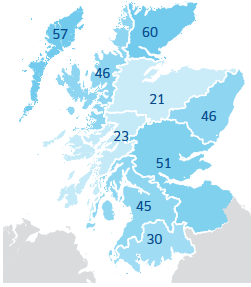
There are clear differences among geographic regions in the relative strength of the 2012 rod catch. The catches in 5 of the 9 regions are ranked within the top 25% of their respective time series. These regions (East, North East, North, North West and Outer Hebrides) are widely geographically distributed across Scotland. Catches from the Moray Firth and West Coast regions produced the lowest rank values, but no region reported catches in the lowest 25% of their time series. Scottish regions are shown in MS Topic Sheet 67 ( http://www.scotland.gov.uk/Topics/marine/science/Publications/TopicSheets/tslist).
Farmed salmon and grilse
A total of 257 fish of farmed origin were reported caught by all methods in 2012. Salmon and grilse of farmed origin represented 0.3% of the total number of salmon and grilse caught, but the distribution of farmed origin fish was highly uneven, the North, North West and West regions accounting for 94% of reports. Scottish regions are shown in MS Topic Sheet 67.
The net fisheries
A total of 12,584 wild salmon and grilse were reported caught and retained in the fixed engine fishery, and the national index of netting effort was 236.5 trap months. A total of 3,646 wild salmon and grilse were reported caught and retained in the net & coble fishery from a reported effort of 78.5 crew months.
Reported catch and effort have declined in both net fisheries over much of the period covered by our records and remain at historically low levels ( Figures 5 & 6). In 2012, fishing effort in the fixed engine and net & coble fisheries was the fifth and sixth lowest, respectively, since records began in 1952. Reported catch in each fishery was 5% and 1% of the maximum reported in the respective time series.
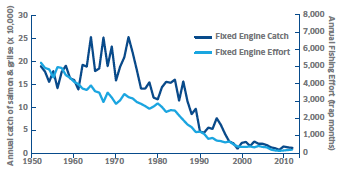
Figure 6 Net and coble fishery
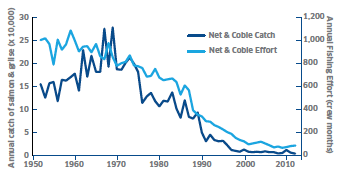
Contact
There is a problem
Thanks for your feedback